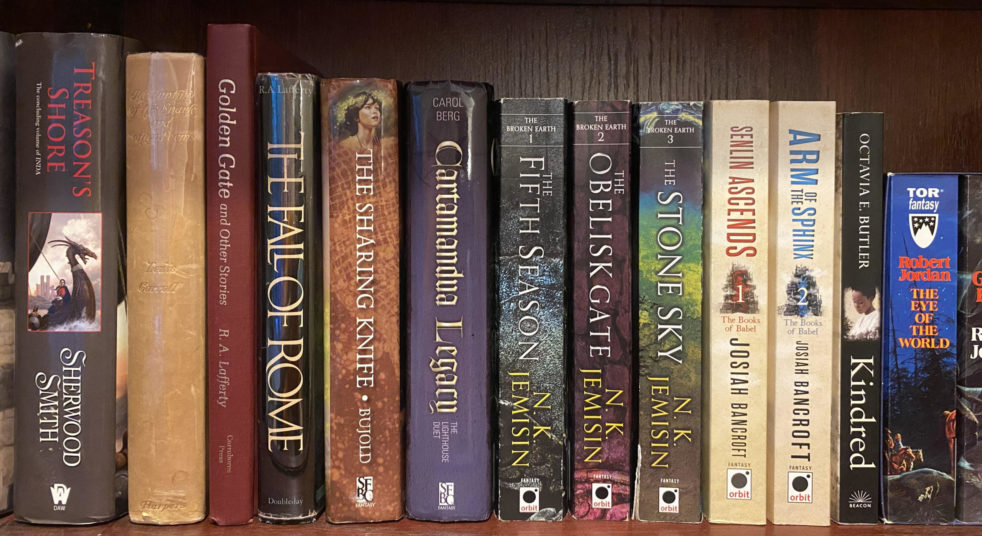In January, I started a new series, which I hope to continue all year, in which I read and review sci-fi/fantasy magazines. I’ve settled on three publications to follow this year: my two favorites from 2022 and a third that has been a titan of the genre for decades. One of those is a bimonthly publication, so April is a short month, with just nine stories in total. But I enjoyed the vast majority of them, so let’s check them out.
Clarkesworld
The April issue of Clarkesworld led very topically, with a pair of intriguing AI stories. First, L. Chan’s “Re/Union” is a touching tale of an annual holiday meal with artificial representations of deceased ancestors, in which the lead character tries everything she can to finally win her mother’s approval. It is followed by “There Are the Art-Makers, Dreamers of Dreams, and There Are Ais” by Andrea Kriz, which dives into an artist’s struggle for meaning in a world where training data is so tightly regulated that even human creators need licenses to sell art inspired by copyrighted material. It’s a fascinating dive into the legal morass surrounding AI art, with an affectingly human story at its core.
My favorite story in this month’s issue is another AI-themed piece, although that feels more like a classic science fiction premise than a dive into implications of current technical development. “Keeper of the Code” by Nick Thomas imagines a far-flung colony in space that has developed an intense religious devotion to the Code that organizes its society. But when the lead finds an artifact mistakenly stored instead of deleted, it spurs a crisis of confidence in the goodness of his world. The religious aspects add a tinge of mysticism, but there’s a very strong emotional and thematic core here.
Moving on to something even stranger, R.T. Ester’s “Rake the Leaves” follows a man trying to interpret messages from parallel universes, possibly delivered through incorrect song lyrics, or perhaps through a collection drone for yard waste. It’s disorienting but fun, and there’s real payoff at the end.
The issue’s two novelettes strike me as having fairly particular audiences, although both certainly have elements to recommend them. Octavia Cade’s “Happiness” is set up as a Choose Your Own Adventure story, but it’s clearly meant to be read straight through, shuffling through a catalog of potential deaths and arguing that all of them would be happy. Early hints of social commentary grow as the novelette progresses, into a fairly pointed call to political and social action. It’s skillfully told in second person, but it did run a tad long for my tastes, and I expect responses will be fairly polarizing based on how didactic readers like their sci-fi. Gregory Feeley’s “Stranger Shores” is his second Clarkesworld piece this year featuring a post-human Mind in a society built around Neptune exploring the realm of humanity. I expect it’s exactly up the alley of many hard sci-fi fans, but much like “The Fortunate Isles,” I had trouble maintaining my interest for the full novelette length.
Shi Heiyao’s “The Librarian and the Robot,” translated by Andy Dudak, joins “Keeper of the Code” as one of my favorites of this month, telling the story of a refugee with a background in cultural preservation reprogramming a military robot to aid in library reconstruction. Though not a story driven by major twists, it’s a satisfying tale of finding meaning even in the most difficult of conditions.
The final piece, Rajan Khanna’s “Voices Singing in the Void,” is the shortest in the issue, a melancholy assortment of reports from terraforming and colony-planning AIs across the universe. There’s not necessarily some grand puzzle that each fragment fits into, but they’re interesting in their own right.
The nonfiction section of this month’s issue includes another followup to the flood AI-written submissions, sharing some of what has worked to stem the tide, and what potential options were simply non-starters. The science piece was about brains in jars, neural cells learning video games, and what it all means for consciousness in science fiction. And the two interviews included one with both the author and translator of Han Song’s Hospital and one with the editors of the first contact science fiction and fact anthology Life Beyond Us. The former was an interesting glimpse into sci-fi in China, and the second—as these interviews often do—had me wondering whether I could squeeze Life Beyond Us into my crowded reading schedule. I struggle with anthologies, but I do love short fiction, and that’s an impressive table of contents.
GigaNotoSaurus
GigaNotoSaurus rolls out one longish story every month, and April’s was their longest of the year to date: Claire Sherzinger’s novella “Sea Wolf.” “Sea Wolf” follows a photographer in Western Canada who had often interacted with the alien shapeshifter Cuzwast before his death at the hands of a hunter. When Cuzwast’s family comes to Earth seeking to be guided through locations that had been important to him, she pushes down her own distress to try to do right by his family. And it gets complicated.
The tour primarily takes place on First Nations land, and some of the family’s lack of care toward environmental protections threaten an already tense relationship among three different peoples. Meanwhile, the death ritual brings to light aspects of Cuzwast’s life that had been opaque to family and friends alike. The result is something of an adventure story and something of a character discovery story, all shadowed by the specter of interspecies murder. There’s certainly plenty here to justify the novella length, and I enjoyed the read from start to finish.
